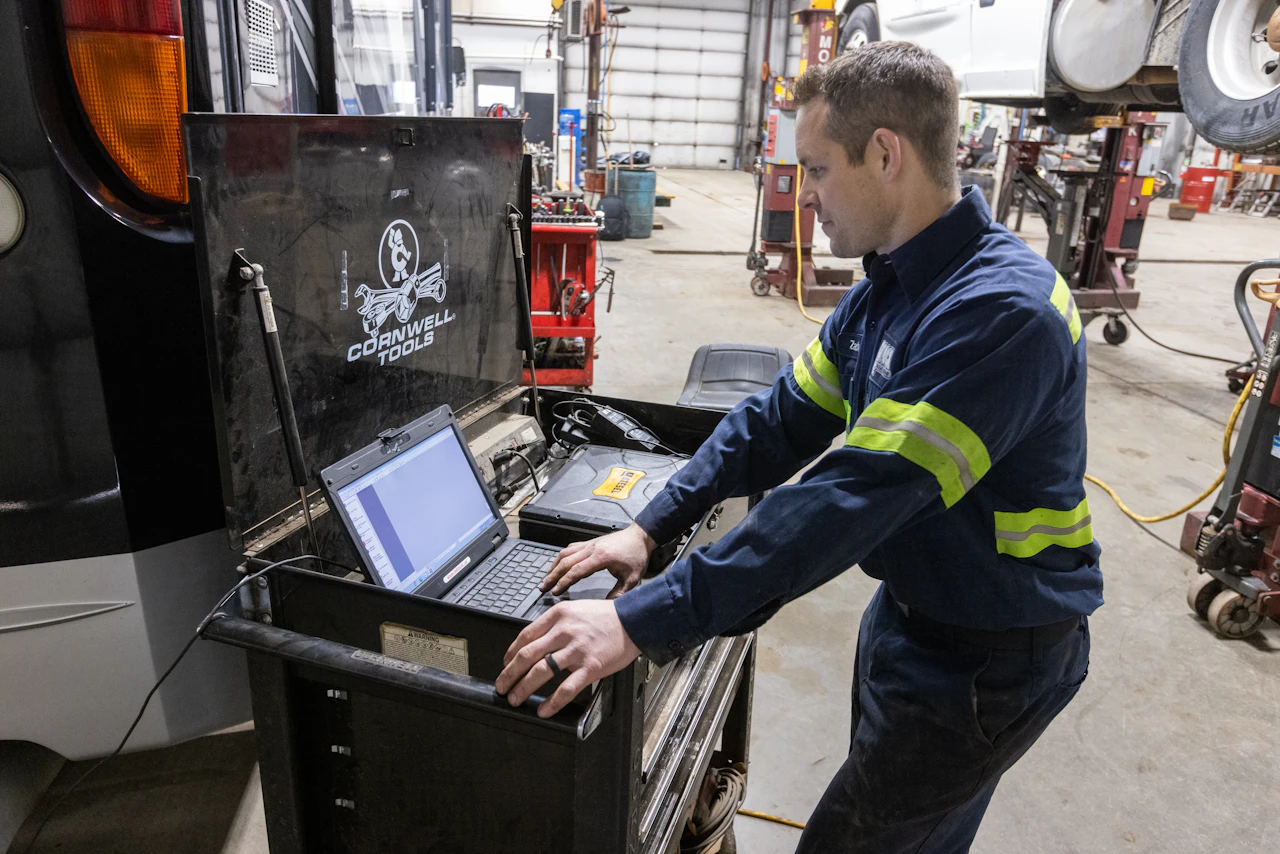Suspension problems can start with a little bounce here, a vague steering feel there, and pretty soon you’re fighting the wheel and chewing tires. The cure is a repeatable playbook of truck suspension diagnostics that separates symptoms from causes.
With a few smart measurements and targeted repairs, you’ll turn the rough ride into a stable performance. Let’s break down the five high-impact truck suspension diagnostics and repairs every operator should have on speed dial.
1) Shock Damping: Test, Confirm, Replace
Shocks don’t carry weight; they control motion. When damping fades and shakes linger after bumps, brake distance stretches on washboard pavement, and tires cup along the shoulders. Build suspension diagnostics around a settle test: roll 10 mph over a speed bump, brake smoothly, and count rebounds.
More than one controlled up/down cycle per corner means the damper’s along for the ride. Inspect for oil weep, bent rods, and torn bushings, then replace in axle pairs with duty-appropriate valving. Lock the result in with torque-stripes and a short road test, documenting bounce count so your diagnostics trend line stays honest.
2) Air Suspension: Bags, Lines, and Height-Control
Air-ride systems carry load and set stance. Start truck suspension diagnostics with an overnight ride-height chalk mark, then time recovery to spec at idle. Soap every fold, bead, and push-to-connect fitting, and don’t ignore height-control linkages—worn joints “hunt,” forcing constant compressor work.
Chronic cycling overheats dryers, pushing wet air into valves that will stick when temps dip. When repairs are needed, renew suspect bags and lines together, center the ride-height setting on the manufacturer’s datum, and recheck after 100–200 miles. Consistency is the whole point of disciplined diagnostics.
3) Leaf Springs, U-Bolts, and Torque Rod Bushings
Steel springs carry static weight and control axle location under torque. Cracked leaves, flattened packs, or stretched U-bolts invite axle wind-up and thrust-angle drift that no alignment can fully mask. Your truck suspension diagnostics should include measuring ride height under typical load, checking center pins, and inspecting torque/shackle bushings for tearing or cold flow.
Replace U-bolts whenever a pack is serviced (they stretch in service), then re-torque to spec after the first heat cycle. Buttoned-up bushings and fresh hardware stop axle steer, protect driveline angles, and make the rest of your truck suspension diagnostics actually stick.
Symptom Decoder
- Shock fade: Persistent bounce after bumps indicates you should prioritize damper replacement within your truck suspension diagnostics.
- Air leak: One corner sitting low after parking suggests focusing diagnostics on bags, lines, and valves.
- Fatigued leaf pack: Harsh bottoming under load means you should verify arch height and U-bolt torque.
- Axle mislocation: Diagonal tire scuffing requires inspection of the torque rod and spring bushings.
- Pneumatic leak or mis-set height valve: A compressor that “never quits” should be confirmed with a recovery-time test.
- Poor damping: Cupped tread blocks show the shocks aren’t controlling unsprung mass effectively.
- Axle wrap or thrust-angle error: Steering pull that changes with throttle means you should update your suspension diagnostics to include bushing checks.
4) Alignment & Thrust Angle
If the drive axle doesn’t point straight, the steer axle has to fight it all day. That’s why thrust angle is the backbone of professional truck suspension diagnostics. Measure and adjust from the frame centerline, not the fenders. You’ll encounter common issues like bent brackets, tired bushings, or uneven spring arch that can twist the picture.
Correcting thrust first stabilizes steering, shortens braking distances, and prevents driver “sawing” that overheats tires and brakes. After any spring, bushing, or air-ride repair, re-verify total toe, caster, and thrust so your truck suspension diagnostics close the loop with numbers—not vibes.
Tools & Measurements That Make You Right
- Digital inclinometer or ride-height gauge: keeps truck suspension diagnostics repeatable across visits.
- Soap solution and a quiet bay: fastest path to pinpointing air leaks.
- Torque wrench with fresh calibration: U-bolts and shock hardware demand accuracy.
- IR thermometer after a test loop: hot drum/rotor on one wheel hints at drag from axle steer.
- Tread depth and durometer tools: quantify wear patterns so repairs prove out.
5) Wheel Ends, Tires & Ride-Height Validation
Tires reveal a lot if you pay attention. Feathering across the ribs usually indicates incorrect toe alignment. Heel-and-toe cupping points to weak damping, while inside-edge wear on trailer tires can signal thrust issues or bushing collapse.
Include wheel-end checks in your suspension diagnostics—hub play, seal leaks, and bearing noise can change camber under load and mimic alignment problems. Finish by verifying the loaded ride height on air-ride suspensions and comparing the arch height on steel-spring axles.
If you record all measurements in your suspension diagnostics worksheet, it confirms that the repair held up and to spot early signs of recurring issues.
Proactive PM Rhythm & Repair Playbook
The most effective truck suspension diagnostics run on a calendar, not just complaints. Add bounce-count, ride-height, bushing inspections, and compressor recovery time to seasonal PMs. Standardize shock part numbers and air-bag SKUs across units where possible; consistent components mean consistent data. When you repair, repair holistically: shocks in axle pairs, bag and line sets together, spring packs with new U-bolts and bushings. Close every job with a short, instrumented road test and a quick doc—numbers, photos of torque-stripes, and tire readings—so your truck suspension diagnostics become a living record, not a one-off guess.
Keep Your Truck Suspension Road-Ready
Vague ride complaints get expensive when they’re ignored. Put structured truck suspension diagnostics to work and fix the cause, not just the noise. Block Diesel Repair Inc. measures, documents, and road-verifies every suspension repair. So the result outlasts the route. Book your suspension evaluation and keep the rig planted for the long haul. For more information, read our guide to picking the right repair partner.

.svg)
.svg)
.svg)